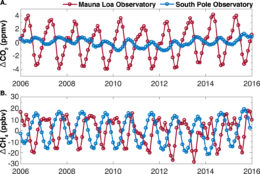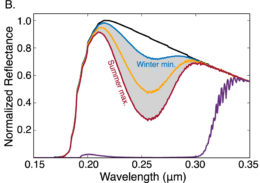There’s no hiding — changes in Earth’s atmosphere over the seasons are a dead giveaway to the fact that Earth hosts life. Now a new study explores whether we might use atmospheric seasonality like Earth’s to detect life on other planets.
Looking for Change
Most of the searches for life beyond our planet focus on identifying static biosignatures, like the presence of methane or large amounts of oxygen in an exoplanetary atmosphere. This approach suffers from many ambiguities, however — including a high likelihood of false positives (processes that chemically mimic life signatures but aren’t life) and false negatives (non-detections despite the presence of life).

Earth’s atmospheric carbon dioxide (top) and methane (bottom) levels vary seasonally, as seen in these data from NOAA’s Earth System Research Laboratory. [Olson et al. 2018]
Seasons and Life
if you’re like me, you probably haven’t spent a lot of time thinking about interactions between the Earth’s biosphere and its axial tilt. Nonetheless, this interplay is responsible for detectable and distinctive seasonal changes in our planet’s atmosphere!

This schematic shows how oxygen and carbon dioxide levels in the atmosphere vary in opposing phase seasonally, with the increased sunlight in summer driving greater conversion of carbon dioxide into oxygen. [Olson et al. 2018]
Olson and collaborators ask a simple question: if our atmosphere varies distinctively in a way that reveals the presence of life on Earth, can we search for similar variation on other planets?
Gaseous Signatures
To answer this question, Olson and collaborators examine the potential for seasonal variation of several atmospheric gases: carbon dioxide, methane, molecular oxygen, and ozone. For a weakly oxygenated planet (like early Earth), the authors find that a detectable indicator of life may be seasonal variations in the strength of ozone spectral bands at ultraviolet wavelengths. This variation serves as a tracer of the seasonality of molecular oxygen.

On a planet with the right conditions, seasonal oxygen oscillations could create an observable difference in the depth of the ozone spectral line, as shown here. [Adapted from Olson et al. 2018]
What is the likelihood that we’ll actually be able to detect seasonal changes in the atmospheric gases of distant exoplanets? More detailed modeling will need to be performed to say for certain — but in the meantime, this study presents an interesting additional technique we can add to our arsenal and explore further in the future!
Citation
Stephanie L. Olson et al 2018 ApJL 858 L14. doi:10.3847/2041-8213/aac171
